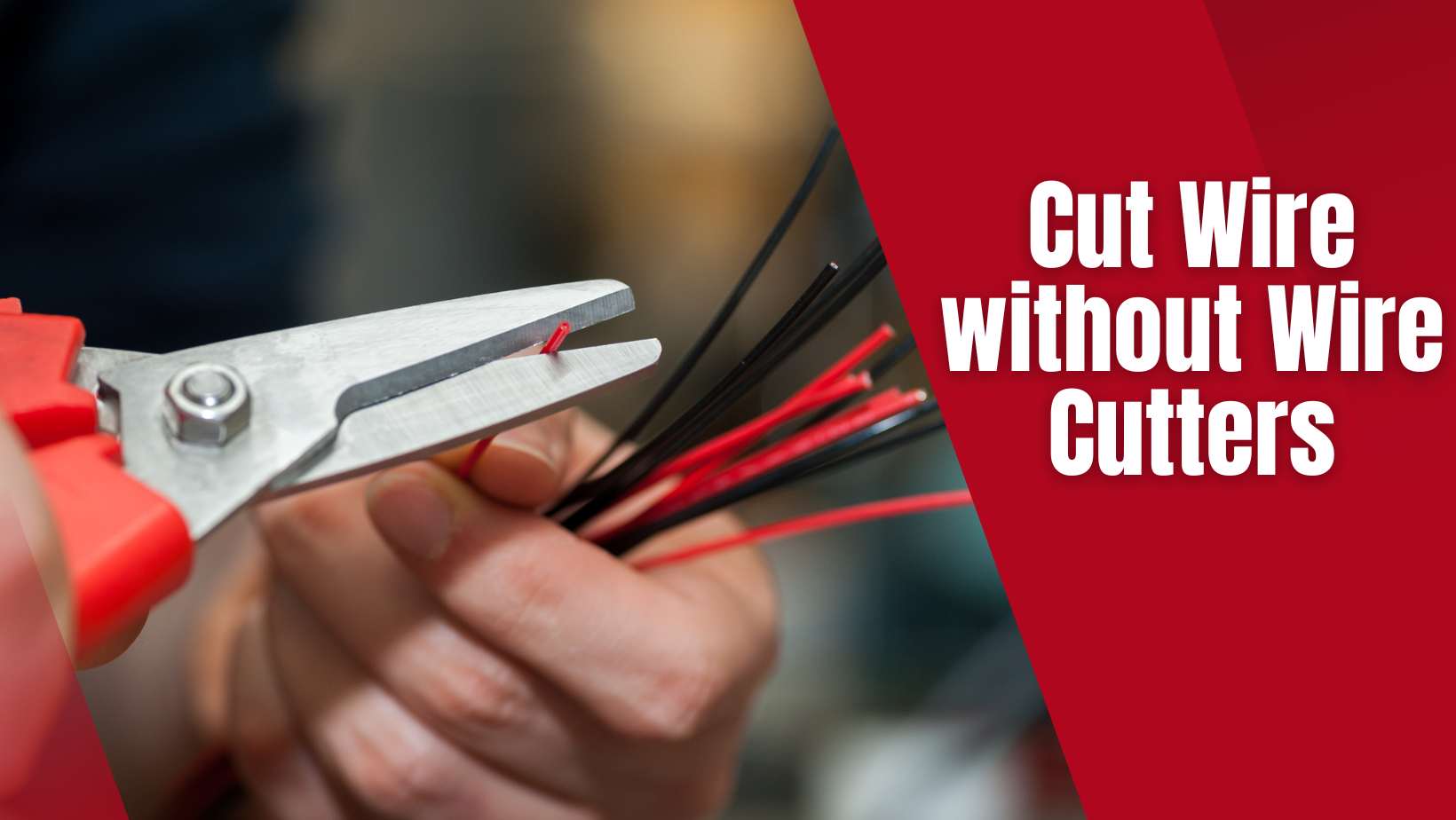Whether working on a DIY project or in an emergency situation, you may find yourself needing to cut wire without having access to a proper pair of wire cutters. While wire cutters are the best tool for cleanly cutting and stripping wire, there are some simple techniques and basic tools that can be used in a pinch to sever copper and other soft metal wires.
In this comprehensive guide, we will explore various methods for cutting wire using common household items. From using scissors and knives, to hacksaw blades and sandpaper, this article covers multiple approaches to get the job done safely and effectively without traditional wire cutters. We’ll also provide tips on how to best prepare the wire, proper hand positioning, and cautionary advice to avoid injury.
By the end, you’ll have the knowledge to quickly and adeptly cut wire with basic supplies. This will empower you to complete electrical projects or respond to emergency situations even without specialized tools. So read on to become an impromptu wire-cutting expert!
Using Scissors
The most straightforward substitute for wire cutters is a simple pair of scissors. Sharp, heavy-duty household scissors, ideally with serrated edges, can cut through thin gauge copper wire in a pinch.
To use scissors to cut wire:
- Grip the wire tightly using pliers or vice grips close to where you want to make the cut. This gives stability and lets you better control the wire.
- Position the scissors at a 45-degree angle across the wire and make sure the tip of the blade aligns with the spot you intend to cut.
- In one smooth motion, squeeze the scissors closed while simultaneously pulling your gripping hand away to sever the wire.
Scissors are best suited for wires up to 16 gauge in thickness. Any thicker, and the force required can damage scissors not specifically built for the task. Additionally, repeatedly cutting thick wire copper can quickly dull scissors.
When using scissors, be extra careful to keep fingertips safely out of the way on either side of the intended cut. Also, eye protection is recommended. Sharp ends of cut wire can fly off with enough force to injure eyes.
Cutting Wire with a Knife
For slightly thicker wires from 14 to 12 gauge, a sturdy utility or pocket knife is the next best option when wire cutters are unavailable. The key is choosing a sharp knife with adequate thickness and leverage to slice through copper wire without bending or breaking the blade.
Follow these safe steps to properly cut wire with an appropriate knife:
- Grip the wire tightly on both sides of your cut line using locking pliers or a vice.
- Position the knife blade perpendicular to the wire and press the edge against its side.
- Applying heavy pressure, slide the knife in a sawing motion multiple times until the wire fully separates.
- Rotate the wire 45 degrees and repeat the sawing motion to ensure a clean cut.
Pro Tip: Serrated knife blades greatly improve cutting ability and reduce required force. Most pocket or utility knives have interchangeable blades. Select a serrated option for easier wire cutting.
As with using scissors, safety glasses and gloves are strongly recommended, along with caution regarding finger placement while cutting. Also, be aware that the newly cut wire ends will likely have sharp burrs and points requiring filing if human handling is expected post-cutting.
Hacksaw Blade
For professional results cutting thicker gauge wire from 10 to 6, a standard hacksaw blade can be extremely effective when used properly. The thin profile and fine teeth are designed to cut metal with precision. Hacksaw blades are typically very rigid, allowing sufficient force application to sever the tough copper wire.
To safely cut wire with a hacksaw blade:
- Secure the wire tightly in a vice or with clamps. Immobilizing it prevents unwanted movement while cutting.
- Grasp the hacksaw blade directly with both hands, gripping tightly with thumbs and forefingers on each side.
- Protect your hands with work gloves. Exposed metal can cut bare skin under pressure.
- Position the hacksaw perpendicular to the wire run and roughly centered on your cutting line.
- Applying firm pressure, run the blade back and forth repeatedly until cutting through the full diameter of the wire. Let the hacksaw do the work. Applying excessive force is unnecessary and unsafe.
Pro Tip: For enhanced control and comfort while hacksawing wire, the blade can be temporarily mounted in a simple handle. Insert the end into a short length of plastic pipe, rubber hose, or even a large cork. This gives a better grip and protects fingers.
The hacksaw approach is extremely effective for cutting most stranded and solid-core copper wire. Just take measures to securely brace the wire, watch finger placement, and let the tool’s sharp teeth slice through the metal. Protective eyewear is also strongly recommended while hacksawing wire due to particles catching in the eyes.
Using Sandpaper
For very fine gauge wires under 22, hacksaws and knives risk damaging thin copper strands. An alternate approach is abrasively wearing through the wire using sandpaper. Though slow, this method can sever solid or stranded wire without harming fine filaments.
To sand cut wire:
- Brace the subject wire firmly in place to prevent slipping while sanding. Use clamps, vice grips or tie off tightly to a secure point.
- Wrap coarse 60 grit sandpaper around your index and middle finger, abrasive side facing inward.
- Position your sanding fingers directly over the intended cut point of the wire.
- Rub vigorously back and forth while applying moderate inward pressure until the copper wire wears through.
- Visually inspect to ensure each fine strand has been severed. Target any remaining uncut strands with a focused rubbing of the edge of the sandpaper.
Pro Tip: The sandpaper will become clogged with copper particles during cutting. Pause regularly to shake the grit clean and keep it cutting fast. You can also tear off thinner strips of sandpaper to concentrate pressure on the wire’s narrow diameter.
While slower, sanding is an inexpensive, simple way to cut very fine gauge wire if wire cutters are not an option. It also gives high control over the cutting point on the wire. Just be extremely cautious. Rapid sanding motion can cause friction burns on fingers if proper hand protection isn’t worn. And as always, safety glasses are critical.
Additional Wire-Cutting Methods
Beyond basic tools, there are also several unexpected everyday items that can be implemented to cut copper wire effectively:
- Carbide tip pens – The extremely hard carbide ball bearings in the tips of these inexpensive pens can slowly cut soft wire when spun aggressively against it.
- Spark plug ceramic – Shards of insulator material from spark plugs also consist of very hard ceramic capable of gradually wearing through copper.
- Aluminum foil – Believe it or not, tightly wrapping aluminum foil across the wire and sawing back and forth creates enough friction heat to melt thin wires.
- Ceramic kitchen knives – Modern ceramic blades are constructed of exceptionally hard sharpened aluminum oxide suited for slicing soft copper.
These alternate methods work in theory. But they require high effort, limited control, and risky improvising. Stick with basic tools like scissors, knives, and hacksaws for consistent, safe DIY wire cutting.
How to Prepare Wire for Cutting?
Now that we’ve covered reliable techniques to cut wire without wire cutters, let’s discuss some quick tips to set up your workpiece for clean, easy cuts:
- Always cut wire significantly longer than your final need. This provides fresh, undamaged ends post-cutting to then strip and install.
- Straighten any kinks and bends in the section to cut. Wire cutters slice best through straight runs.
- Wrap tape around the intended cut point to prevent the wire from reclosing and pinch points while cutting.
- If the wire has insulation, first score through the shielding fully around to expose the inner copper.
- Use alcohol or acetone to remove any surface dirt, oil, or grime from the wire. This keeps cutting edges from loading with gunk.
- With thin stranded wire, twist the ends slightly to bunch and tighten the filaments.
Properly preparing your wire takes seconds but dramatically improves the cutting performance of household tool substitutes. Don’t risk damaging fine-stranded conductors or dulling cutting edges by slicing haphazardly. Take a moment to set up your workpiece first.
How to Safely Hand Cut Wire?
Before attempting any DIY wire-cutting method without the proper tools, implementing adequate safety measures is critical. While commonly worked materials, both copper wire and cutting blades can cause serious injury when handled recklessly. Here are smart precautions to follow:
- Always wear safety glasses. Bits of wire and cutting edges can easily fly into the eyes.
- Use thick rubber gloves. These protect hands from both sharp wire ends and cutting implements while improving grip.
- Secure wire with clamps or pliers so it doesn’t slip during cutting. This also keeps fingers safely clear of the cut point.
- Gripting tools low near the cutting edge for maximum leverage and control. This prevents slips.
- Cut wire decisively in one quick motion per attempt. Sawing slowly increases the chances for tool deflection.
- Mind finger and hand placement very carefully before attempting each cut. Never reach across or underneath the wire while cutting.
Working patiently and methodically while implementing basic protective wear significantly reduces the chances of bodily injury. Rush jobs almost always result in mistakes and cuts. If safety becomes a concern at any point while attempting to hand-cut wires, stop and reassess techniques to ensure you don’t endanger yourself or others.
FAQs
Here are answers to some frequently asked questions about cutting wire without traditional wire cutters:
Can I use household scissors to cut thick 12-gauge copper wire?
It’s not advisable. Scissors are only intended for thin gauge wires around 16 and below. Attempting to cut thicker 12 gauge risks damaging scissors or personal injury if the blades slip.
What should I use to safely brace and grip the wire while cutting with improvised tools?
Locking pliers, vice grip pliers, or a hobby vise anchored to a secure workbench are ideal for keeping wire immobilized during cutting. Always grip as close to the cut point as possible.
What are the best types of gloves to wear while cutting wire?
Thick rubber or work gloves provide insulation if contacting live electrical wires. Leather gloves also supply cut protection. Latex or nitrile gloves simply improve grip and protect from minor abrasions.
How do I smooth dangerous sharp wire ends after cutting without strippers?
Carefully filing the ends of the cut wire removes any sharp burrs and pinpoints. Use a fine metal file and stroke away from your fingers. An alternate method is repeatedly folding over and pinching the wire tip with sturdy pliers.
Can I cut live electric wiring in an emergency with basic hand tools?
Cutting energized wire using improvised, uninsulated tools is extremely dangerous with the risk of lethal electric shock. ALWAYS disengage power sources before attempting any impromptu wire-cutting methods.
Conclusion
As detailed in this comprehensive guide, while wire cutters are specially designed for the task, many basic household items can be substituted when unavailable. Using proper precautions, technique, and the right cutting tool for specific wire gauges, copper conductors can be safely, and effectively hand-cut.
Remember to prepare wires appropriately before cutting and take measures to securely grip workpieces. Sagely select cutting implements based on wire thickness. And exercise great care regarding hand positioning relative to cutting blades and wire itself while sawing.
With this knowledge, anyone can expertly cut copper wire in a workshop or emergency situation without traditional wire cutters! Just utilize sound judgment, appropriate tool selection for the gauge wire, and implement safety precautions. You’ll find the wire severing both simple and safe.

